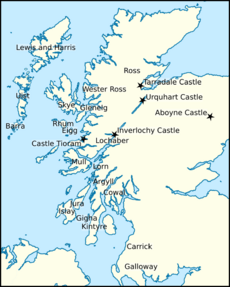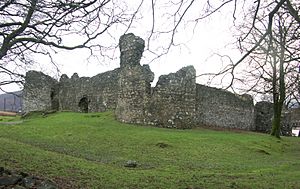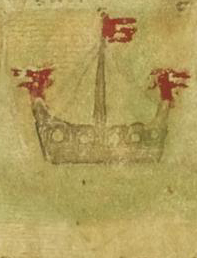Lachlann Mac Ruaidhrí facts for kids
Quick facts for kids
Lachlann Mac Ruaidhrí
|
|
|---|---|

Lachlann's name as it appears in correspondence between John Strathbogie, Earl of Atholl and Edward I, King of England
|
|
| Predecessor | Ailéan mac Ruaidhrí |
| Successor | Ruaidhrí Mac Ruaidhrí |
| Noble family | Clann Ruaidhrí |
| Father | Ailéan mac Ruaidhrí |
Lachlann Mac Ruaidhrí was an important Scottish leader who lived from around 1297 to 1307 or 1308. He was the chief of a powerful family group called Clann Ruaidhrí. Lachlann was a very active fighter during the First War of Scottish Independence. He bravely stood up against powerful figures like John, King of Scotland, Edward I, King of England, and even his rival, William II, Earl of Ross. Lachlann's name stops appearing in records around 1307 or 1308. It seems his brother, Ruaidhrí, took over as the chief of Clann Ruaidhrí after him.
Contents
About Clann Ruaidhrí
Lachlann was a son of Ailéan mac Ruaidhrí. Ailéan was the son of Ruaidhrí mac Raghnaill, Lord of Kintyre, who was the person the Clann Ruaidhrí family was named after. Lachlann had another brother named Ruaidhrí and a sister named Cairistíona.
The Clann Ruaidhrí was part of a larger family group called Clann Somhairle. Other important branches of this family included Clann Dubhghaill and Clann Domhnaill. Lachlann married a daughter of Alasdair Mac Dubhghaill, Lord of Argyll. This marriage made Lachlann connected to other powerful families. He was brother-in-law to Alasdair Mac Dubhghaill's son, Eóin Mac Dubhghaill. He was also likely related by marriage to the chief of Clann Domhnaill, Alasdair Óg Mac Domhnaill, Lord of Islay.
Lachlann's Actions
Fighting Against English Supporters
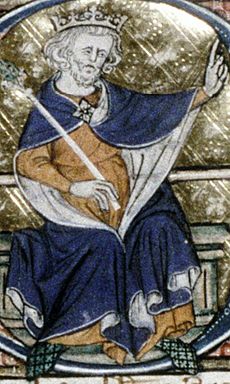
Lachlann's father, Ailéan, likely died by 1296. Although Lachlann's sister, Cairistíona, was supposed to inherit their father's lands, her brothers soon took control. Lachlann is first mentioned in records in 1292. At that time, Edward I, King of England, was trying to keep peace in the Hebrides (islands off Scotland). Alasdair Mac Dubhghaill promised Edward I that he would help control the Clann Ruaidhrí, as Lachlann and others were not willing to obey the English king.
In 1293, John, King of Scotland, tried to bring order to the western parts of his kingdom. He created new sheriff areas. The area of Skye and nearby islands was given to William II, Earl of Ross. The area of Lorn and other islands was given to Alasdair Mac Dubhghaill. However, these new sheriffs often used their power against local rivals. Clann Ruaidhrí had problems with the Earl of Ross over control of areas like Kintail, Skye, and Uist. The Earl of Ross later wrote to the English king in 1304, recalling a costly fight he had in the 1290s against rebellious island chiefs, including Lachlann.
In 1296, Edward I invaded and easily took over Scotland. Many Scottish leaders were imprisoned, including William II, Earl of Ross. He was held captive for seven years. During this time, Lachlann and his brother took advantage of the situation where there was no strong leader. Lachlann showed loyalty to Edward I in 1296, like most other Scottish landowners.
Edward I used Alasdair Óg Mac Domhnaill as his main agent in the west. Alasdair Óg tried to stop the Clann Dubhghaill from rebelling against English rule. There were many fights between these two powerful families. Alasdair Óg complained to Edward I that Alasdair Mac Dubhghaill had attacked his lands. He also said that Lachlann and Ruaidhrí attacked him and damaged Skye and Lewis and Harris. Alasdair Óg asked Edward I for help from other noblemen to fight the king's enemies.
In another letter, Alasdair Óg complained that he faced a united front from Lachlann, Ruaidhrí, and the Comyns (another powerful family). He said that people in Lochaber had sworn loyalty to Lachlann. Alasdair Óg chased his opponents to Inverlochy Castle, a Comyn stronghold. There, he destroyed two very large warships, which he called the biggest in the Western Isles. He again asked the English king for money to fight his many opponents.
These letters show that Lachlann and Ruaidhrí wanted to take control of Skye and Lewis and Harris from the Earl of Ross, who was away. They attacked these islands to gain control. The fighting between Clann Ruaidhrí and Clann Domhnaill shows that both families wanted to expand their own lands. It's likely that Clann Ruaidhrí's actions were a continuation of earlier conflicts over the control of Skye. The letters also show that Lachlann and Ruaidhrí could split their forces and fight separately. This made them hard to defeat.
Fighting Against Scottish Patriots
Not much is known about Lachlann's activities until 1299. An English spy reported that news of attacks by Lachlann and Alexander Comyn (brother of John Comyn, Earl of Buchan) reached a meeting of the Scottish leaders. This news was so serious that it immediately stopped a big argument among them.
In 1301, Edward I told his admiral to make peace with Alasdair Mac Dubhghaill, his sons, Lachlann, and Lachlann's wife and their followers. This shows that the English thought it was important to make peace with Clann Dubhghaill. This peace might have been a way for the family to improve their position or because Clann Domhnaill was succeeding against them.

In 1304, John Strathbogie, Earl of Atholl, wrote to Edward I. He suggested that Lachlann was still working with Alexander Comyn. John Strathbogie was worried because Alexander Comyn had two strong castles and was working with Lachlann. Lachlann was trying to build up his navy by getting one warship for every piece of land he controlled. John Strathbogie got this information from William II, Earl of Ross. The lands mentioned were likely Clann Ruaidhrí territories like Uist, Barra, the Small Isles, and perhaps Skye.
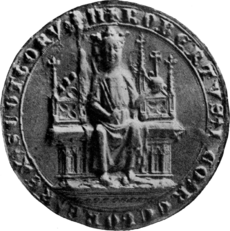
In February 1306, Robert Bruce VII, Earl of Carrick, who wanted to be king of Scotland, killed his main rival, John Comyn III of Badenoch. Robert Bruce became King Robert I in March. However, the English king immediately fought back and defeated Robert I's forces. By September, Robert I was a fugitive, meaning he was hiding. He seems to have escaped to the Hebrides.
According to an old book from the 1300s, Lachlann's sister, Cairistíona, played a very important part in Robert I's survival. She gave him shelter along Scotland's western coast when he was at his lowest point. However, Lachlann himself seems to have sided with the English. He swore loyalty to Edward I in August 1306 and asked for lands that belonged to a supporter of Robert Bruce.
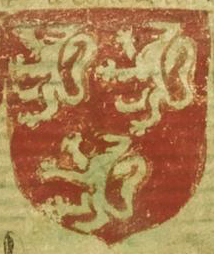
In October 1306, messages from the English king were sent to William II, Lachlann, Ruaidhrí, and Eóin Mac Neacail. Eóin Mac Neacail was an early member of Clann Mhic Neacail, a family likely based on Skye and Lewis and Harris. It's possible that the Earl of Ross had made an alliance with Clann Mhic Neacail against Clann Ruaidhrí. William II was a close friend of the person who delivered these messages. This suggests that the Earl of Ross had brought these families back under his influence. William II also played a key role in Robert I's troubles around this time. He captured Robert I's wife and daughter and handed them over to Edward I. The messages might have been about this event.
Fighting Against the Earl of Ross
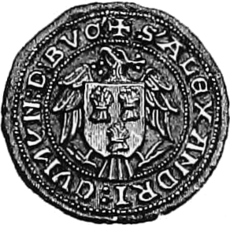
In 1303, William II, Earl of Ross, was released from prison in England after seven years. He might have refused to swear loyalty to the English until then, only doing so to protect his lands. When he returned, one of his jobs was to bring the Hebrides under control. However, he faced a strong alliance between Alexander Comyn and Lachlann, who was growing more powerful. This hostile group might explain why the Earl of Ross wrote to Edward I, trying to make Lachlann and Alexander Comyn look bad, while highlighting his own usefulness to the English. By 1306, the English king gave Alexander Comyn's former castle, Urquhart, to William II.
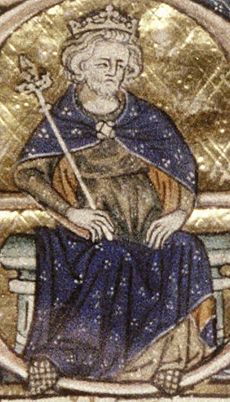
Lachlann is last mentioned in records in 1307 or 1308. This was in letters between William II and Edward II, King of England. At that time, the Earl of Ross was in a dangerous position. Robert I was attacking the Earl of Buchan, who was defeated in 1308. William II also told Edward II that Lachlann refused to pay the money he owed to the English king. William II said that Lachlann "is such a high and mighty lord, he'll not answer to anyone except under great force or through fear of you."
This letter shows how strong Clann Ruaidhrí was at that time, almost as strong as the Earl of Ross. It's possible that because of Clann Ruaidhrí's influence, Robert I found support in Ross. Robert I's success against William II might have come from important island leaders like Lachlann. In 1308, the Earl of Ross finally gave in to Robert I. This helped stop the fighting with his Clann Ruaidhrí enemies. After Lachlann's last appearance in records, his brother Ruaidhrí seems to have taken over as the leader of Clann Ruaidhrí.
Who Came Next?
Ruaidhrí seems to have gained control of the family lands only after swearing loyalty to King Robert I. At some point during Robert I's reign, Lachlann's sister, Cairistíona, gave up her claims to the lands. She did this with a condition: if Ruaidhrí died without a son, and her own son (who had the same name as Ruaidhrí) married one of Ruaidhrí's daughters, then Cairistíona's son would inherit the lands. We don't know exactly why the king allowed Ruaidhrí to take control over Cairistíona, who was a close supporter of the king. But it's clear that Ruaidhrí's loyal service to the king helped his family continue to be powerful.
Some historians in the early 1900s described Lachlann and his family as "Highland rovers" or like "Vikings" because of their actions against other families. Later, in the 1900s, Lachlann was still seen as a "sinister figure" or a "troublemaker." However, these descriptions might be too simple. Records show that Lachlann and his family were strong regional lords who were very active in the conflicts of their time. According to a manuscript from the 1400s, Lachlann had a son named Raghnall.


